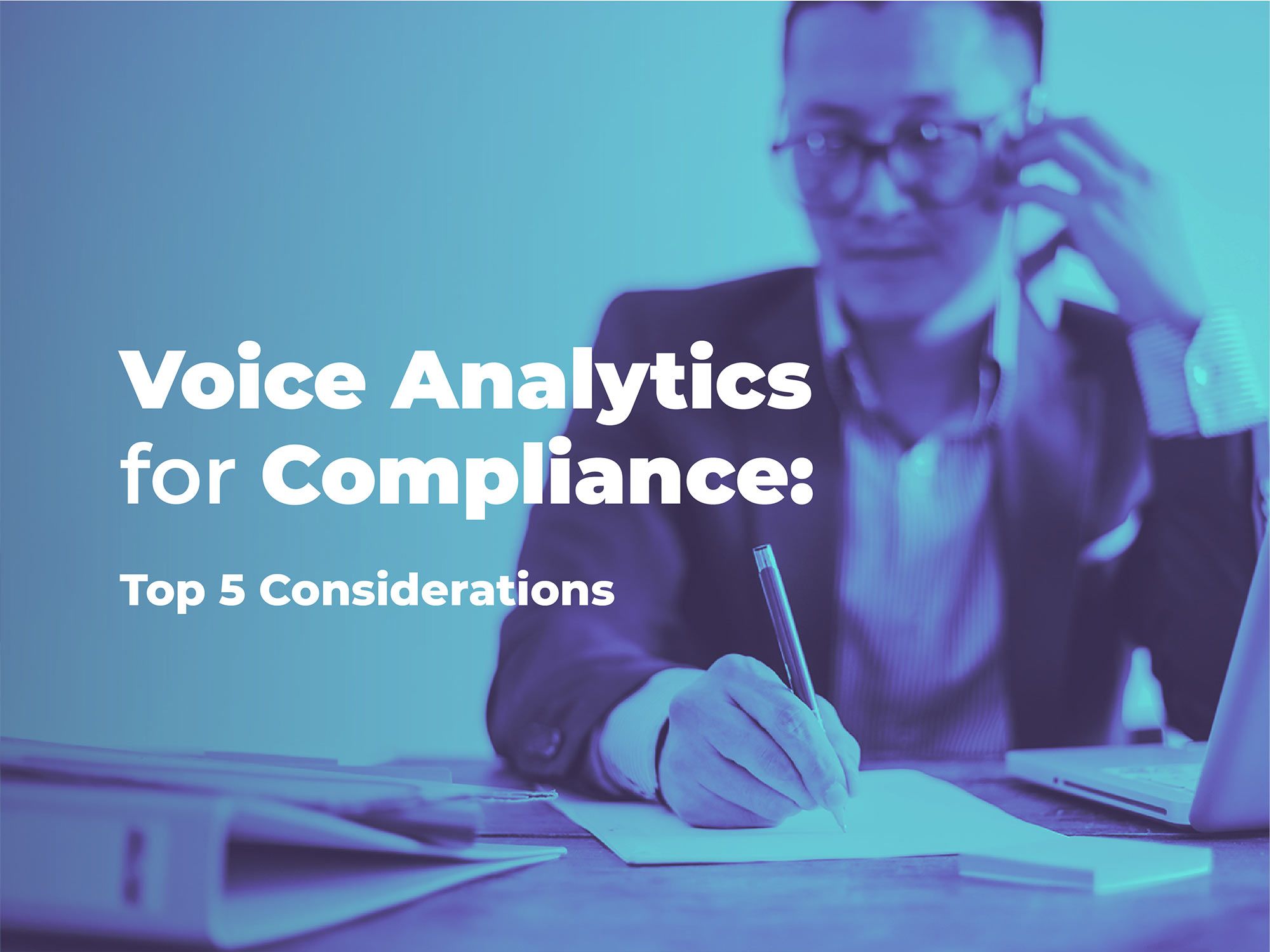Top considerations for voice analytics

Key considerations when adopting a voice analytic system for compliance
Selecting voice analytic systems for compliance requires a better understanding of compliance and risk, future risk management trends, and how technologies like AI & Automation that can support a successful risk transformation program.
Many voice analytical systems are limited to topics of interest or keyword spotting, which is not aligned with organizational compliance and risk management objectives. Transitioning to an automated system requires several considerations and action plans around it.
Here are the Top-5 areas that require consideration and the questions to ask while adopting one.
Compliance Coverage
Non-financial risk, including compliance and conduct risk, is where organizations usually have guidelines, standards, supervision frameworks, and training regimes. Compliance requirements may include conduct-related obligations, industry codes, and policies. Sometimes, there are state-level obligations besides the federal laws. In addition, each product and service has T&C and disclosure requirements that must be fulfilled at the operational level.
So, what matters here?
- Is the compliance coverage comprehensive, and can we support a standard-based approach?
- Is our compliance monitoring principles-based or a random review? How do we keep a principles-based approach?
- How is regulatory change supported, operationalized, and monitored?
Risk-based supervision
Risk-based supervision has a significant role in promoting good conduct. In seeking to ensure that customers are treated fairly, for example, an risk-based supervision approach assesses the risks of unfairly treating customers and the adequacy of controls to prevent this.
Supervisors are usually resource-constrained, so this approach increases the effectiveness of supervision through improving supervisory outcomes while also increasing efficiency through improved resource allocation and processes.
It involves allocating resources to the areas of most significant risk.
In contrast to a tick-box-based approach, each policy is prioritized based on the fines, reputational damage, customer detriment, and cultural aspects.
So, what matters here?
- Do we currently prioritize each obligation and policy differently?
- How do we standardize risk criteria?
- How do we factor-in risk in our assessments?
Incident and breach reporting
It is essential to label the occurrence that may or may not involve a compliance breach, a complaints escalation, a sensitive customer data breach, or serious misconduct by a staff member, among other things.
Classifying various events as incidents and breaches from an automated supervision system is critical. KRI & KPI can also determine the type of event.
So, what matters here?
- The volume of incidents, what we must know vs. what is good to have? How do we address false positives?
- Can I understand each event's impact, for example, cost and reputational damage?
- Can I do internal and regulatory reporting based on specific obligations and policy breaches?
- How do we support regulatory inquiries? Do we have enough detail?
Actionable insights
Actionable insights give various stakeholders like customer experience, risk/compliance, and supervisors the ability to leverage insights and act upon them. These factors will dictate your response and thus how well you can minimize the financial, regulatory, and reputational risks to you, your company, and the customers you serve. For example,
- Which departments should get involved
- What actions should be taken
- How the occurrence will be resolved
- Whether notification will be required
- Who to notify, when to notify, and how to notify
So, what matters here?
- How can we shift the focus of the supervision team from information collection to information analysis post-automated supervision model?
- Can we configure a role-based action plan?
- Can we achieve timely remediation and continuous improvement?
- How can we support peer review & quality assurance and measure daily performance improvement?
- How can we create a perfect balance between compliance, quality, and customer experience and drive strategic initiatives
- Can the CX, Compliance, and QA teams have specific insights to act on and improve operational processes?
- How can we benchmark our progress based on the actions taken?
Explainable AI & Humans in the loop
While the accuracy of the predictions is critical, it should not be the only criteria to evaluate, and the operationalization of AI technology requires serious consideration.
Operationalization and incorporation of AI into business can be pretty challenging and require considerable planning. Therefore, the voice analytic system should be able to integrate seamlessly and should not be limited as a complementary function. AI-explainability and Humans in the loop are key features that can help in this direction.
In contrast to a "black box" based approach AI system can provide details on how it arrived at such a decision. AI explainability is essential for internal assessments and regulatory investigations, which can be supported by an evidence-based approach and explain how a conclusion has been made.
An automated supervision process driven by AI must be able to learn and adapt from the business users' knowledge in the decision-making process, gain experience, and repeat the same. Human in the loop is a capability where various business users like the Customer Experience, Quality, and Compliance team can provide input based on the respective business domain and feedback.
So, what matters here?
- How can we capture the feedback from the business users and incorporate the learnings in future predictions?
- Can it support AI explainability, and how well is the human bias managed?
- What are the boundaries when it comes to delegating supervision to machines look like?
- How do humans need to be involved in the loop and day-to-day decisions making process?
